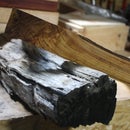Introduction: Vintage Guitar Bluetooth Speaker
I had been toying with this build for some time. Pretty much since I picked up this guitar when my boss was clearing out the prop closet at the outdoor ed program I worked at. It's a no name guitar, that was broken and was never going to be strung again.
Unfortunately, when I made this project I didn't think to document it fully. I apologize for the post build recap photos. It turned out better than I thought it would, so I wanted to share!
You don't need many tools for this build, just a drill and a saw to be honest. If you're better than me at disassembling electronics, you won't need the soldering iron.
Step 1: Step 1: Take Chance on Questionable Bluetooth Speaker
I stopped into a Big Lots on a whim looking for supplies for another project, when I saw this bluetooth speaker on sale for $10 USD. I had been rolling this build around in my head for a while, and when I saw the price I decided to try it out. Worst case scenario, I was out $10 and a dusty guitar that was taking up space in the basement.
The hardest part of the this was trying to disconnect the terminals that attached the speakers to the circuitry. I gave up and used a pair of wire cutters. After pulling out all the essential pieces (IE, the control panel and speakers) I cut the box up.
The piece that held the control panel was used as a template to mark the holes for cutting, and the piece that held the speakers was going to hold the speakers... INSIDE A GUITAR BODY!!!
Step 2: Cut a Hole
This is where you don't want to use a nice guitar (anything with a manufacturers label, costs more than free, or still plays is out). We're going to cut a hole in the body of the guitar and basically ruin it.
Any saw will work. I used a jig saw, but a coping saw, sawzall, or even on of those oscillating cutters will work fine. Simply drill four holes large enough for your blade at each corner and get to work. A quick clean up with sandpaper will take care of any tear out.
Step 3: Glue in Speakers, Inhale Fumes, Panic, Run to Kitchen
I wasn't planning on reusing anything from the original housing, but I couldn't figure out a good way to position the speakers in the guitar with any sort of confidence. So I decided to reuse the mounting board from the speaker box. This created a new challenge: How do I glue it in?
I knew that regular wood glue was out. I couldn't get in to clamp the piece, and the weight of the speakers would have pulled the board over anyways. CA Glue dries much faster, and since this piece wasn't going to be structural it should be strong enough. Plus it's Adam Savage approved.
I seem to have odd luck with CA glue. In this case, I caught a full face of the fumes, realized that it wasn't setting fast enough, and hastily ran (AKA deliriously stumbled) into the kitchen to grab baking soda. Baking Soda acts as a kick to CA glue, causing it to set almost immediately. My fume addled brain also remembered Adam Savage mentioning he would use it to help build up a fillet to add strength.
I threw in half a teaspoon of the stuff, dumped in more glue and wondered how many years I had just taken off my life.
Step 4: Reconnect the Wiring
After I went inside, drank some water and regained my senses, it was time to hook everything back up. The wires are color coded and incredibly thin. Technically it's easy, but the small gauge made this very tedious work. Before twisting them together, I slid on two pieces of heat shrink tubing. It's better than electrical tape for covering over splices.
I globbed on some solder and used a lighter to seal it in.
Step 5: Drill, Screw, Repeat
Whoever wired up my speakers originally must have been paranoid about the terminals coming apart. They had been sealed with hot glue and despite my best efforts, weren't coming apart. When I re-connected the wires, I had just permanently installed this speaker into guitar half way through the build.
I used the control panel as a guide for drilling the four mounting holes. Simply fit the panel in place and carefully drill through the existing holes with a small drill bit. I used the smallest one I could find. The screws aren't very long or wide and the guitar body is made of questionable material. A small hole leaves more material to bite into.
Step 6: Enjoy the Music
With everything buttoned up, you're ready to rock. Turn it on, sync the devices, and enjoy the music.

Participated in the
Amps and Speakers Contest 2016













